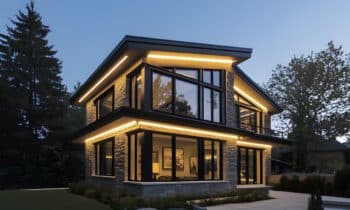
Overseas production has long been the backbone of the lighting industry. But as tariffs rise and supply chains shift, the ripple effects are reshaping how projects are specified, priced, and delivered.
“WHEN TARIFFS HIT OVERSEAS PRODUCTION,THE COST DOESN’T JUST STAY OVERSEAS IT SHOWS UP IN EVERY BID, EVERY FIXTURE,AND EVERY PROJECT TIMELINE.”

For decades, the lighting industry has been built on a global foundation. Fixtures, components, and raw materials flow across borders before landing in homes, offices, and job sites. Overseas manufacturing, particularly in Asia, has played a central role in keeping costs competitive, driving innovation, and delivering the scale that the industry depends on. But as recent years have shown, global reliance comes with risks. Trade tariffs, supply chain disruptions, and shifting manufacturing hubs are reshaping the economics of lighting—and the effects are being felt from factory floors to project bids. For specifiers and contractors, understanding how these changes ripple through the industry is critical to staying competitive and keeping projects on track.
Why Overseas Manufacturing Became the Norm
Lighting is uniquely suited to overseas production. High-volume manufacturing, access to specialized components, and cost efficiencies in labor and materials all drew companies abroad. For many years, this global model allowed manufacturers to hold down costs while still pushing forward with product innovation. The challenge is that overseas reliance also means exposure. Shifts in policy, tariffs, and shipping costs don’t stay confined to the factory—they flow straight into the landed cost of fixtures.
The Tariff Effect on Projects
In recent years, tariffs on Chinese-manufactured goods—ranging from 10 to 30 percent—have had a measurable impact on lighting products. What looks like a modest increase at the import level quickly multiplies once margins, distribution, and retail costs are applied. For a contractor, that might mean a fixture that once cost $75is now closer to $90. For a specifier, it can mean redesigning around alternative solutions to meet a budget. For developers and owners, entire projects can creep beyond planned costs. The effects of global trade policy aren’t abstract—they land directly on the job site. Specifiers face tough conversations with clients about rising costs compared to earlier projects. Contractors are squeezed between higher material prices and fixed bids, with tighter margins and greater risk. Owners maybe forced to scale back scope or reconsider design features to stay on budget.
The industry, however, has not stood still. Many manufacturers have responded with strategies to soften the blow:
- Diversifying production to countries like Indonesia, Vietnam, and Mexico to reduce tariff exposure.
- Bulk purchasing and raw material stockpiling to lock in costs and buffer against volatility.
- Streamlining product design to reduce complexity by consolidating SKUs or creating multi-use fixtures.
- Investing in North American assembly to bring more stability and shorten lead times.
These efforts don’t eliminate the impact of tariffs, but they demonstrate how agile the industry must now be to keep costs under control and projects on track.
“IN TODAY’S MARKET, UNDERSTANDING THE SUPPLY CHAIN IS AS IMPORTANT AS UNDERSTANDING THE SPEC SHEET.”
For those on the front lines of projects, awareness and collaboration are key. Contractors and specifiers can’t control tariff policy, but they can control how they respond to it:
- Work closely with manufacturers and reps to understand sourcing and lead times.
- Build flexibility into specifications to adapt if certain SKUs become cost-prohibitive or delayed.
- Factor global trade realities into project budgets—assuming costs will remain flat is a risk.
Looking Ahead
The global nature of lighting isn’t going away. Overseas production will remain central to the industry, but diversification, smarter design, and closer collaboration are already helping to create stability. For specifiers and contractors, the lesson is clear: global shifts eventually become local realities. By paying attention to the bigger picture, the industry can stay resilient—even in the face of change.

Lighting at a Glance
Global Manufacturing & Tariffs — QuickStats
- 70–80% of lighting sold in NorthAmerica is still manufactured in Asia(primarily China, Vietnam, andIndonesia).
- Tariffs on Chinese goods range from10–30%, depending on product category.
- A 10% tariff on a $50 landed cost fixture can raise the final retail price by 15–20% once distribution and margins are applied.
- Lead times for overseas shipments rose from an average of 30–45 days pre-2020 to 60–90+ days at peak disruption, and remain elevated.
- Production in Indonesia and Vietnam has grown by double digits in the past five years as companies diversify sourcing.


